Dynamic Amplitude-Frequency Characteristics of Vertical–Torsional Coupling System with Harmonic Response in Hot Tandem Mill
Abstract
:1. Introduction
2. Mathematical–Physical Model and FE Model
2.1. Brief Introduction of the F3 Rolling Mill
2.2. Mathematical and Physical Model of Vertical–Torsional Coupling
2.3. Verification of the Developed Models
2.3.1. Vibration Test of Vertical System of Rolling Mill
2.3.2. Vibration Test of Rolling Mill Drive System
3. Harmonic Response Analysis and Experiments
3.1. Sensitive Frequency Analysis
3.2. Sensitive Frequency Variation under Strip Thickness Fluctuations
3.3. Sensitive Frequency Changes under Strip Hardness Fluctuations
4. Conclusions
- (1)
- From the amplitude versus frequency characteristics curve of the hot tandem mill, we observed that a coupled vibration between the primary drive and vertical systems is required. Additionally, the thickness fluctuation at the entrance of the F3 rolling mill has the greatest impact on the vertical and horizontal vibrations. However, the fluctuation has less of an impact on the axial vibration, and the amplitudes of the vertical, horizontal, and axial vibrations increase with the thickness. In addition, the influence of the thickness fluctuation of the rolling mill’s entrance on the torsional vibration is relatively small, and the torsional amplitude value gradually decreases with the increase in the entrance thickness fluctuation.
- (2)
- The fluctuation of the strip hardness has the greatest impact on the vertical and horizontal vibrations of the hot tandem rolling mill and has a less of an effect on torsional and axial vibrations. The vibrational amplitude decreases gradually towards horizontal vibrations.
- (3)
- When suppressing the vibration of the hot tandem mill, it is suggested to reduce the thickness fluctuation of the strip entry while matching the strip’s quality; meanwhile, increase the strip entry hardness fluctuation.
- (4)
- The change trend of the amplitude-frequency response curve of the hot tandem rolling mill does not increase uniformly with the fluctuation of the strip thickness, while the influence trend of the strip hardness fluctuation on the change in the amplitude-frequency response curve is uniformly decreased.
- There are some necessary structural simplifications in the establishment of the F3 rolling mill stand simulation model, such that there is an error between the damping coefficient of the simulation model and the actual rolling mill stand’s structural damping value.
- There is a certain error in the setting of the restraint mode of the harmonic response analysis model in the Ansys Workbench, the addition of the load, and the actual dynamic process state of the rolling mill.
- The sensor itself has a measurement error with respect to the field vibration signal measurement.
- We believe that the coupling between the horizontal, vertical, and axial modes may lead to the existence of this difference, and our follow-up research will further investigate this aspect.
Author Contributions
Funding
Conflicts of Interest
References
- Peng, Y.; Zhang, M.; Sun, J.-L.; Zhang, Y. Experimental and numerical investigation on the roll system swing vibration characteristics of a hot rolling mill. ISIJ Int. 2017, 57, 1567–1576. [Google Scholar] [CrossRef]
- Hwang, R.; Jo, H.; Kim, K.S.; Hwang, H.J. Hybrid model of mathematical and neural network formulations for rolling force and temperature prediction in hot rolling processes. Access 2020, 8, 153123–153133. Available online: https://ieeexplore.ieee.org/abstract/document/9167204 (accessed on 23 June 2022).
- Younes, M.A.; Shahtout, M.; Damir, M.N. A parameters design approach to improve product quality and equipment performance in hot rolling. J. Mater. Process. Technol. 2006, 171, 83–92. [Google Scholar] [CrossRef]
- Zeng, L.; Zang, Y.; Gao, Z. Effect of rolling process parameters on stability of rolling mill vibration with nonlinear friction. J. Vibroeng. 2016, 18, 1288–1306. Available online: https://www.extrica.com/article/16569 (accessed on 25 June 2022).
- Peng, R.; Zhang, X.; Shi, P. Vertical-Horizontal coupling vibration of hot rolling mill rolls under multi-piecewise nonlinear constraints. Metals 2021, 11, 170. [Google Scholar] [CrossRef]
- Qian, C.; Zhang, L.; Hua, C.; Bai, Z. Adaptive fuzzy vertical vibration suppression control of the mechanical-hydraulic coupling rolling mill system with input dead-zone and output constraints. Access 2020, 8, 85793–85801. [Google Scholar] [CrossRef]
- Liu, S.; Ai, H.; Pang, Z.; Lin, Z.; Zhao, D. Hopf bifurcation control of nonlinear electromechanical coupling main drive system of rolling mill. EPJ Plus 2020, 135, 365–379. [Google Scholar] [CrossRef]
- Peng, Y.; Cui, J.; Sun, J.; Zhang, M. Torsional vibration for rolling mill with the drive system shaft axis deviations. Arab. J. Sci. Eng. 2021, 46, 12165–12177. [Google Scholar] [CrossRef]
- Lu, X.; Sun, J.; Li, G.; Wang, Z.; Zhang, D. Stability analysis of a nonlinear coupled vibration model in a tandem cold rolling mill. Shock Vib. 2019, 2019, 12165–12177. [Google Scholar] [CrossRef]
- Xu, T.; Hou, D.X.; Sun, Z.N.; Guo, D.W. Vibration characteristics of multi-parametric excitations and multi-frequency external excitations of rolling mill under entry thickness fluctuation of strip. J. Iron Steel Res. Int. 2020, 17, 517–527. [Google Scholar] [CrossRef]
- Zhu, Y.; Qian, P.; Tang, S.; Jiang, W.; Li, W.; Zhao, J. Amplitude-frequency characteristics analysis for vertical vibration of hydraulic AGC system under nonlinear action. AIP Adv. 2019, 9, 5019–5027. [Google Scholar] [CrossRef]
- Shi, P.-M.; Li, J.-Z.; Jiang, J.-S.; Liu, B.; Han, D.-Y. Nonlinear dynamics of torsional vibration for rolling mill’s main drive System under parametric excitation. J. Iron Steel Res. Int. 2013, 20, 3091–3095. [Google Scholar] [CrossRef]
- Mosayebi, M.; Zarrinkolah, F.; Farmanesh, K. Calculation of stiffness parameters and vibration analysis of a cold rolling mill stand. Int. J. Adv. Manuf. Technol. 2017, 91, 4359–4369. [Google Scholar] [CrossRef]
- Du, G.; Gao, C.; Li, R.; Guo, X. An analysis on strip vibration coupled with torsional vibration of main drive system of rolling mill. J. Vibroeng. 2017, 19, 5679–5690. [Google Scholar] [CrossRef]
- Hou, D.; Peng, R.; Liu, H. Analysis of Vertical-Horizontal Coupling Vibration Characteristics of Rolling Mill Rolls Based on Strip Dynamic Deformation Process. Shock. Vib. 2014, 2014, 1–11. [Google Scholar] [CrossRef]
- Rusnák, J.; Malega, P.; Svetlík, J.; Rudy, V.; Šmajda, N. The research of the rolling speed influence on the mechanism of strip breaks in the steel rolling process. Materials 2020, 13, 3509. [Google Scholar] [CrossRef] [PubMed]
- Liu, S.; Ai, H.; Lin, Z.; Meng, Z. Analysis of vibration characteristics and adaptive continuous perturbation control of some torsional vibration system with backlash. Chaos Solitons Fractals 2017, 103, 151–158. [Google Scholar] [CrossRef]
- Liu, S.; Ai, H.; Sun, B.; Li, S.; Meng, Z. Bifurcation and chaos of electromechanical coupling main drive system with strongly nonlinear characteristic in mil. Chaos Solitons Fractals 2017, 98, 101–108. [Google Scholar] [CrossRef]
- Wu, L.; Ma, S.; Deng, P.; Huang, Q. Research on the modeling of bending-torsional coupling and vibration characteristics of planetary roller screw mechanism. Electronics 2022, 11, 1395. [Google Scholar] [CrossRef]
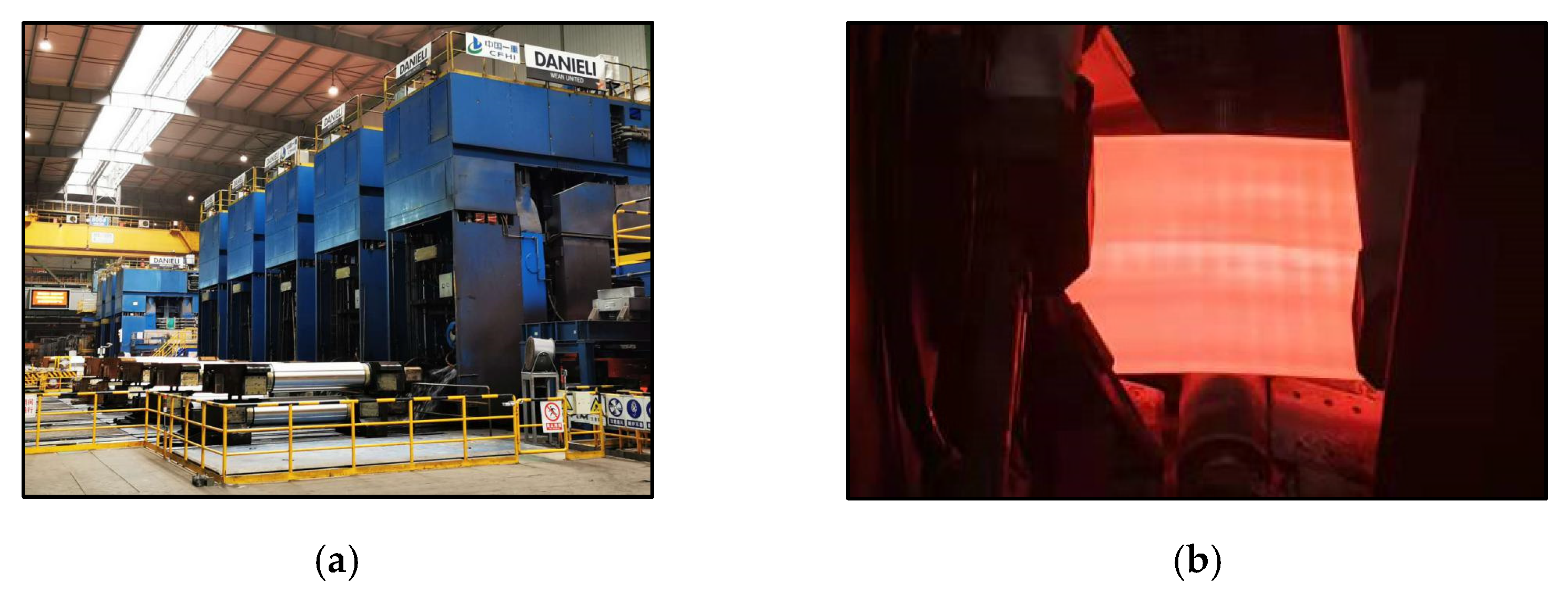
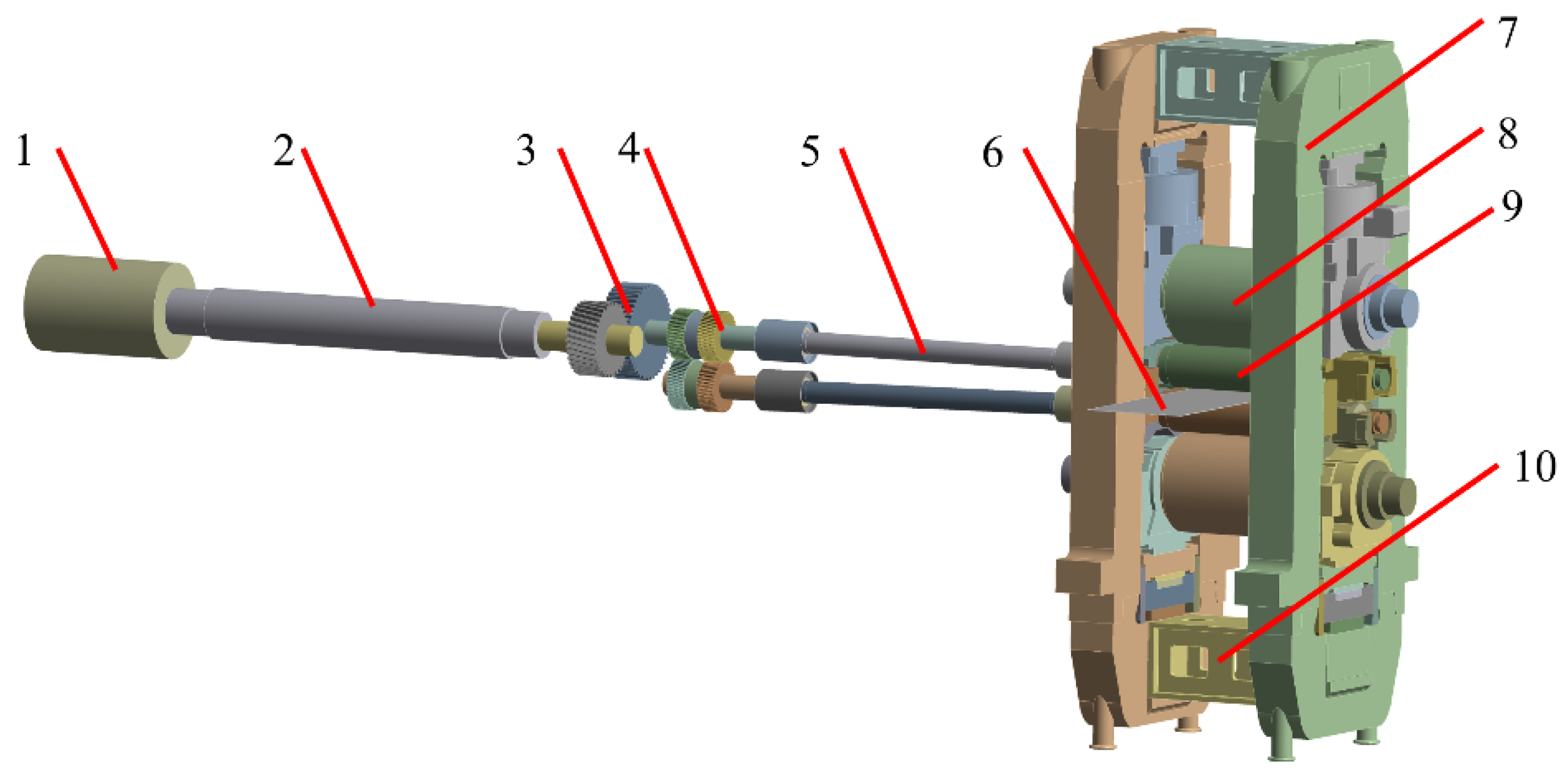





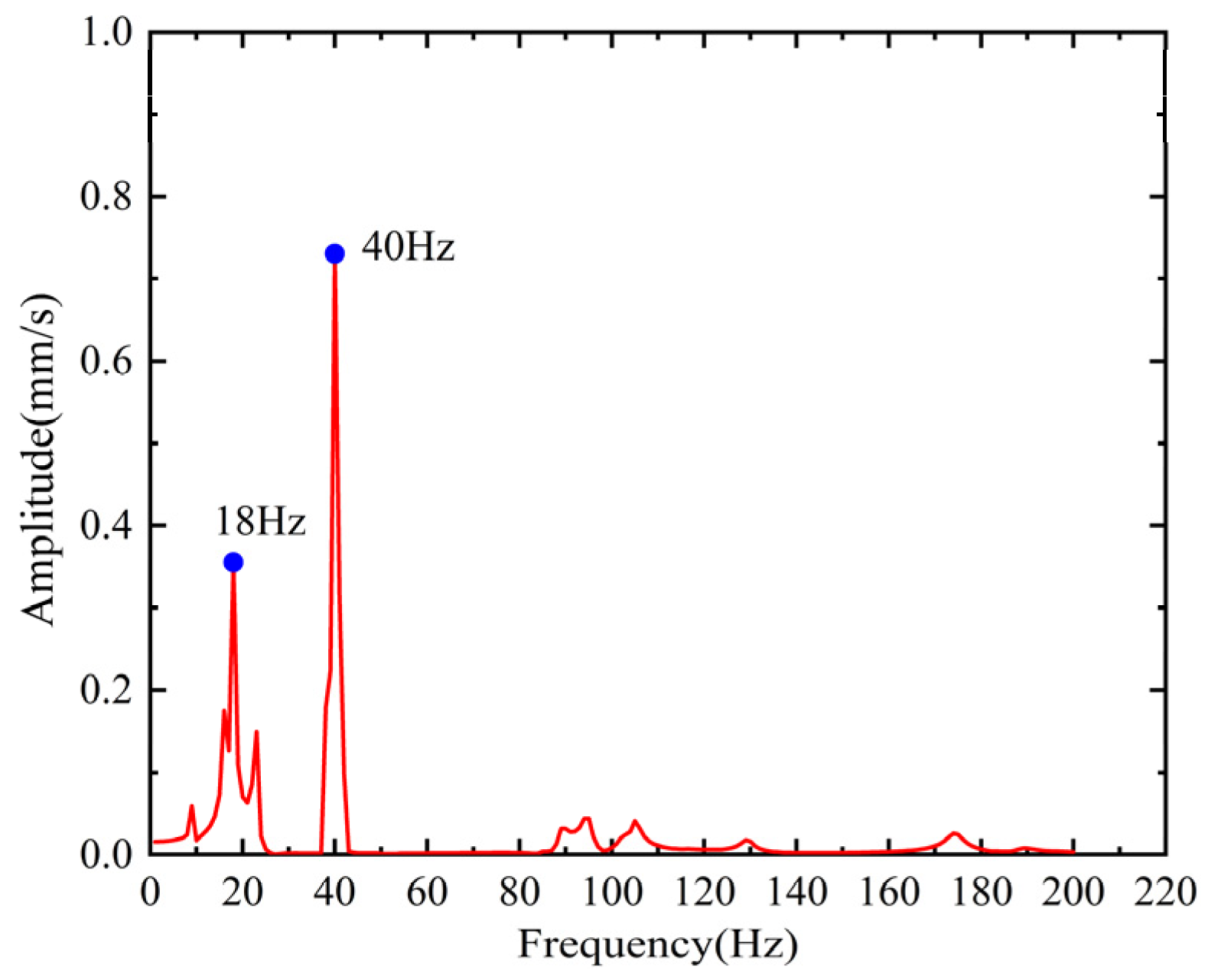

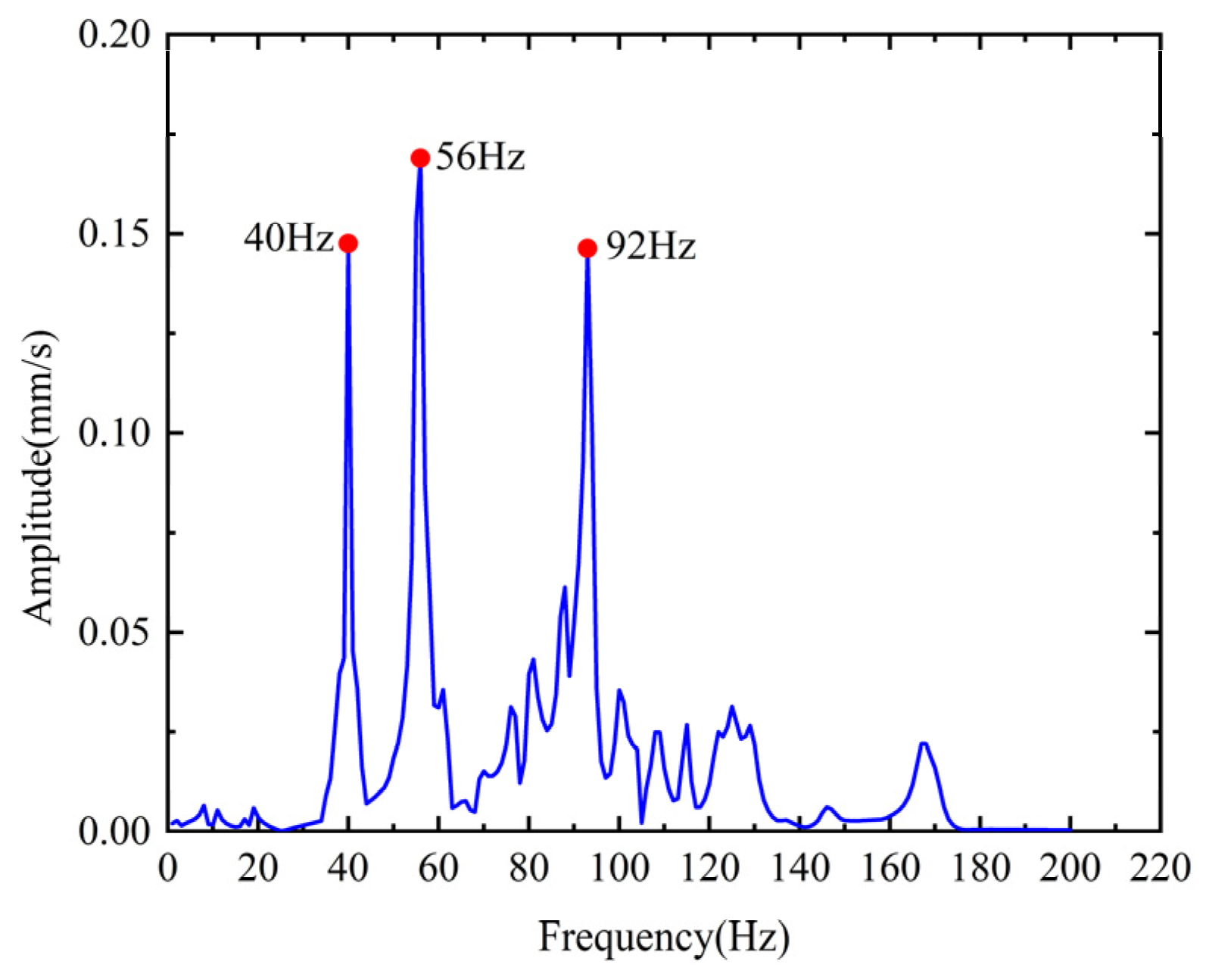
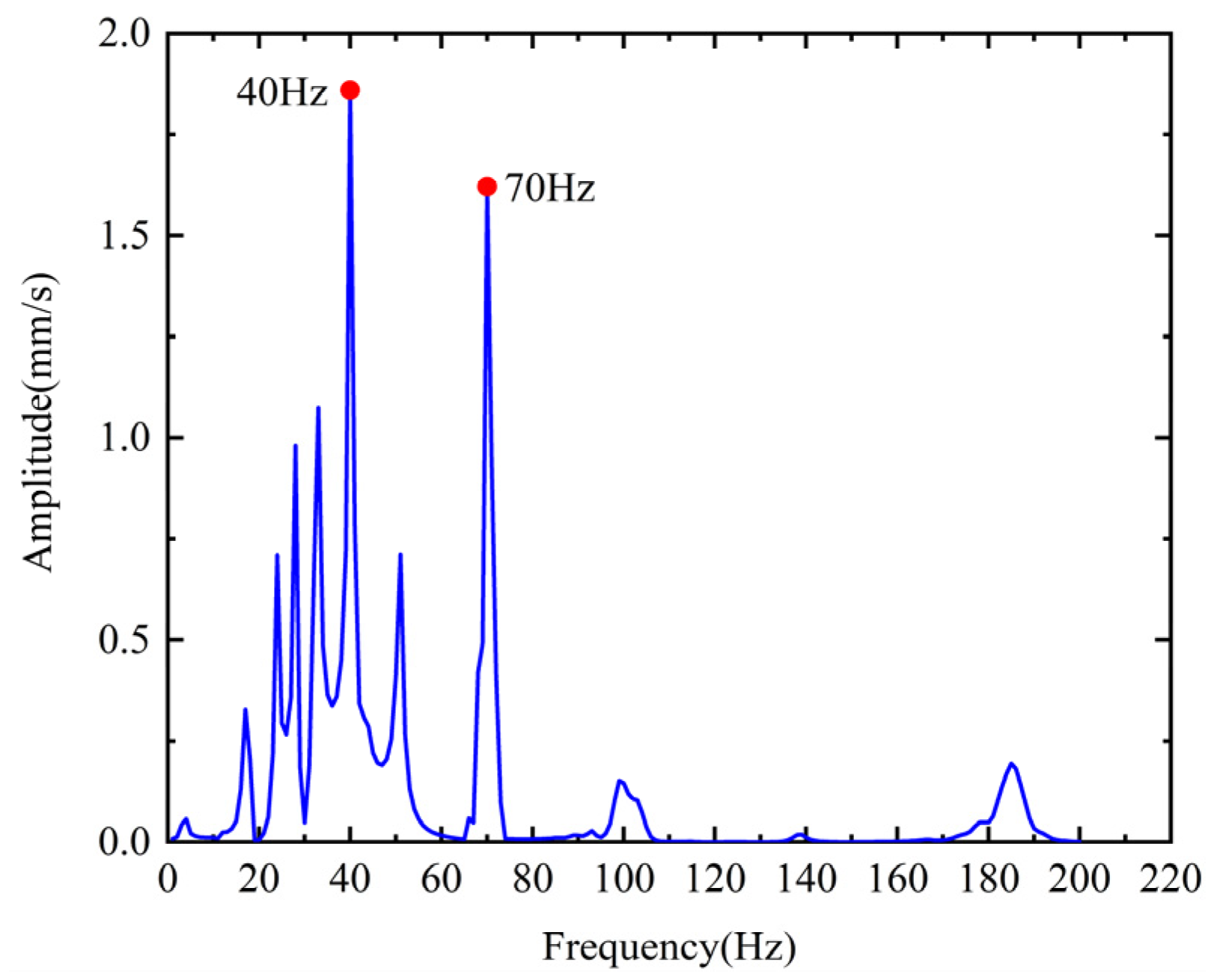
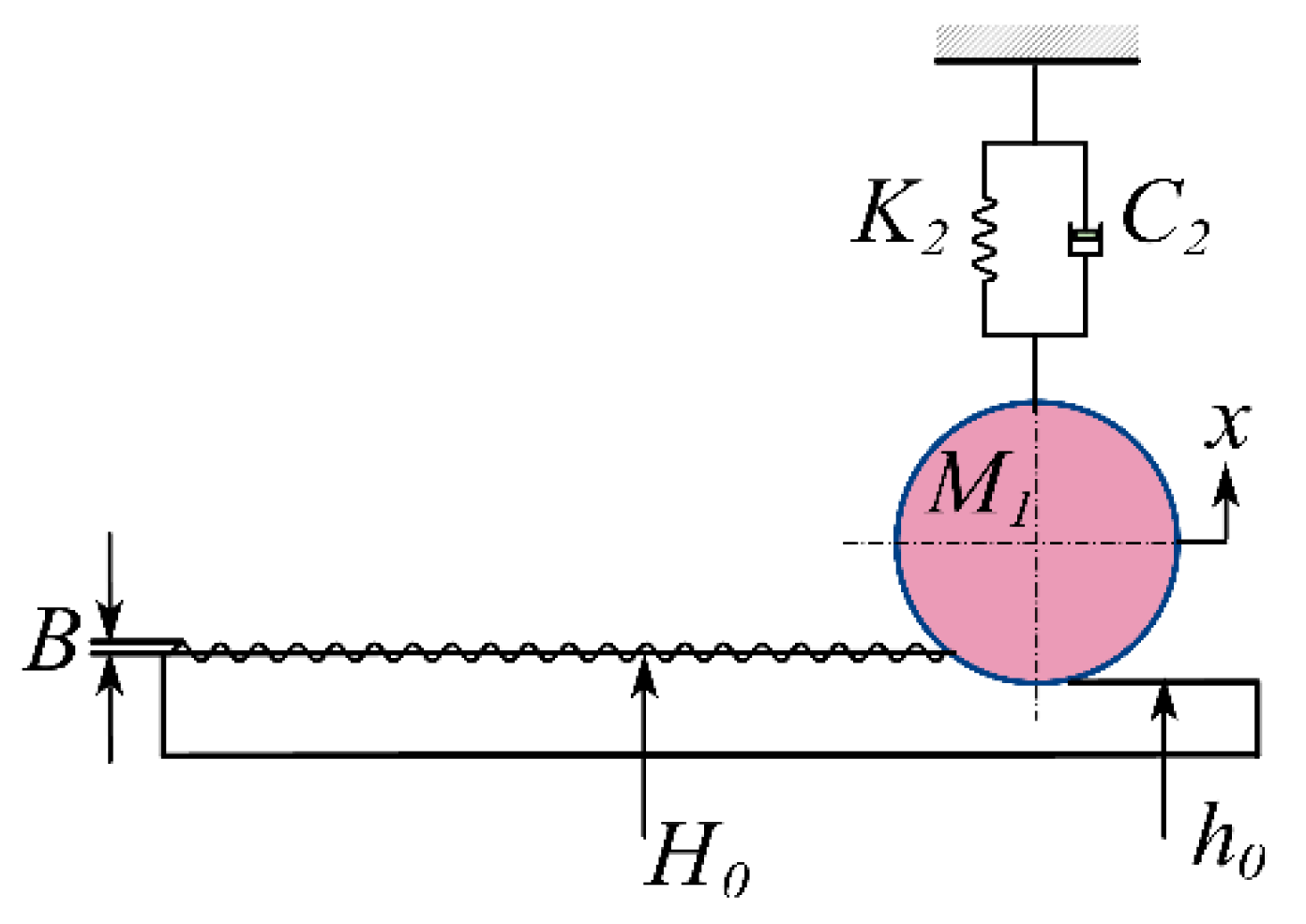
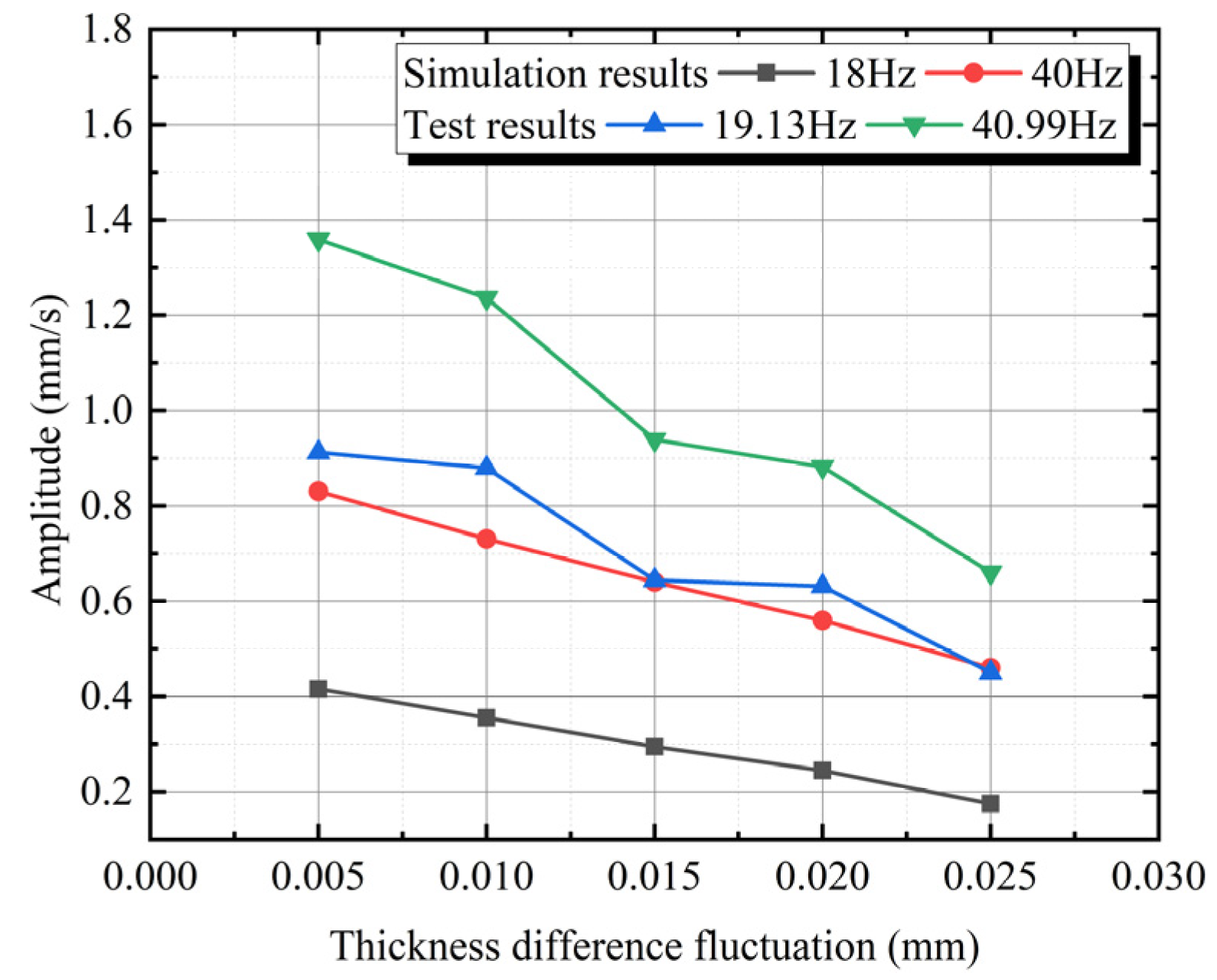
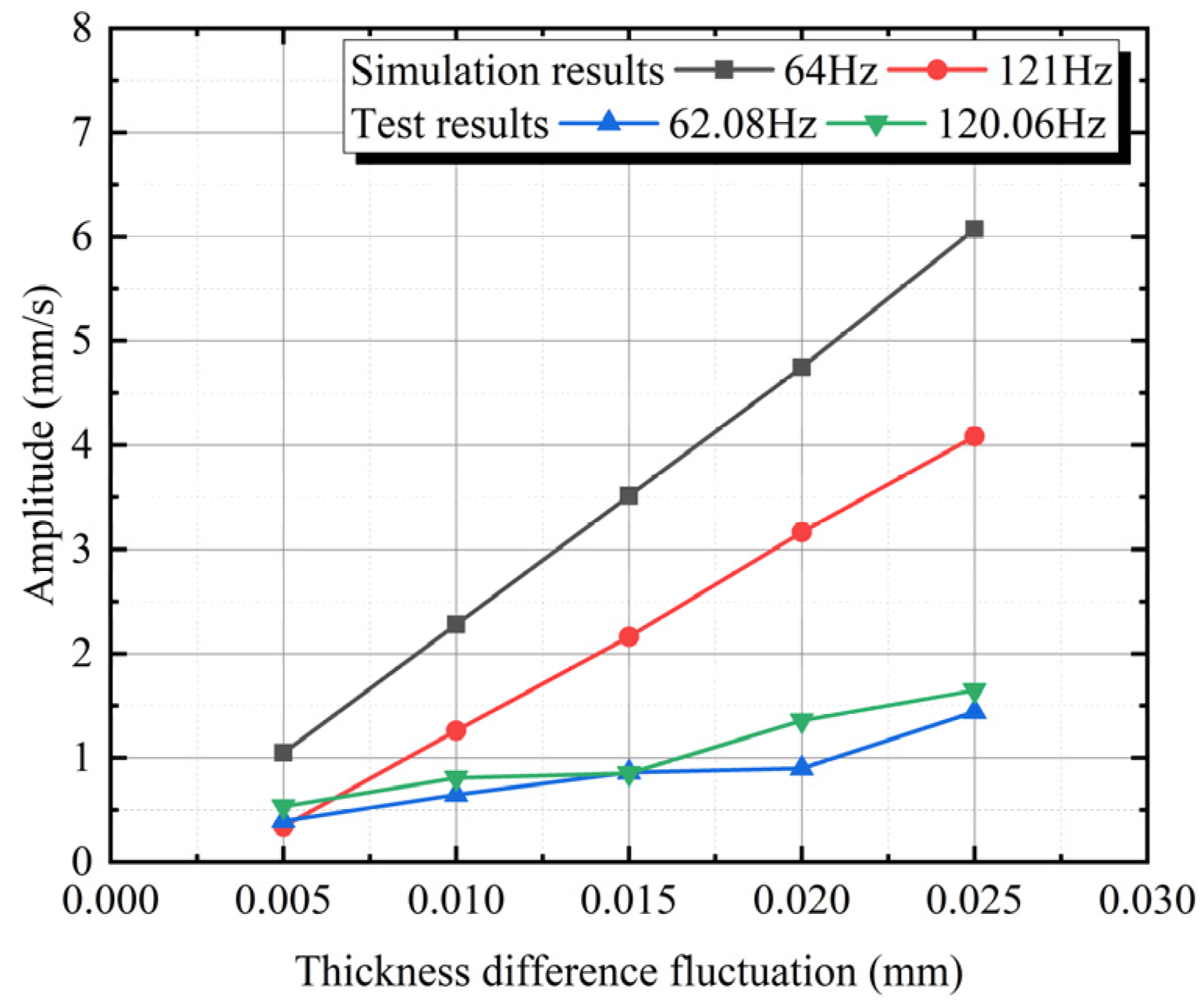
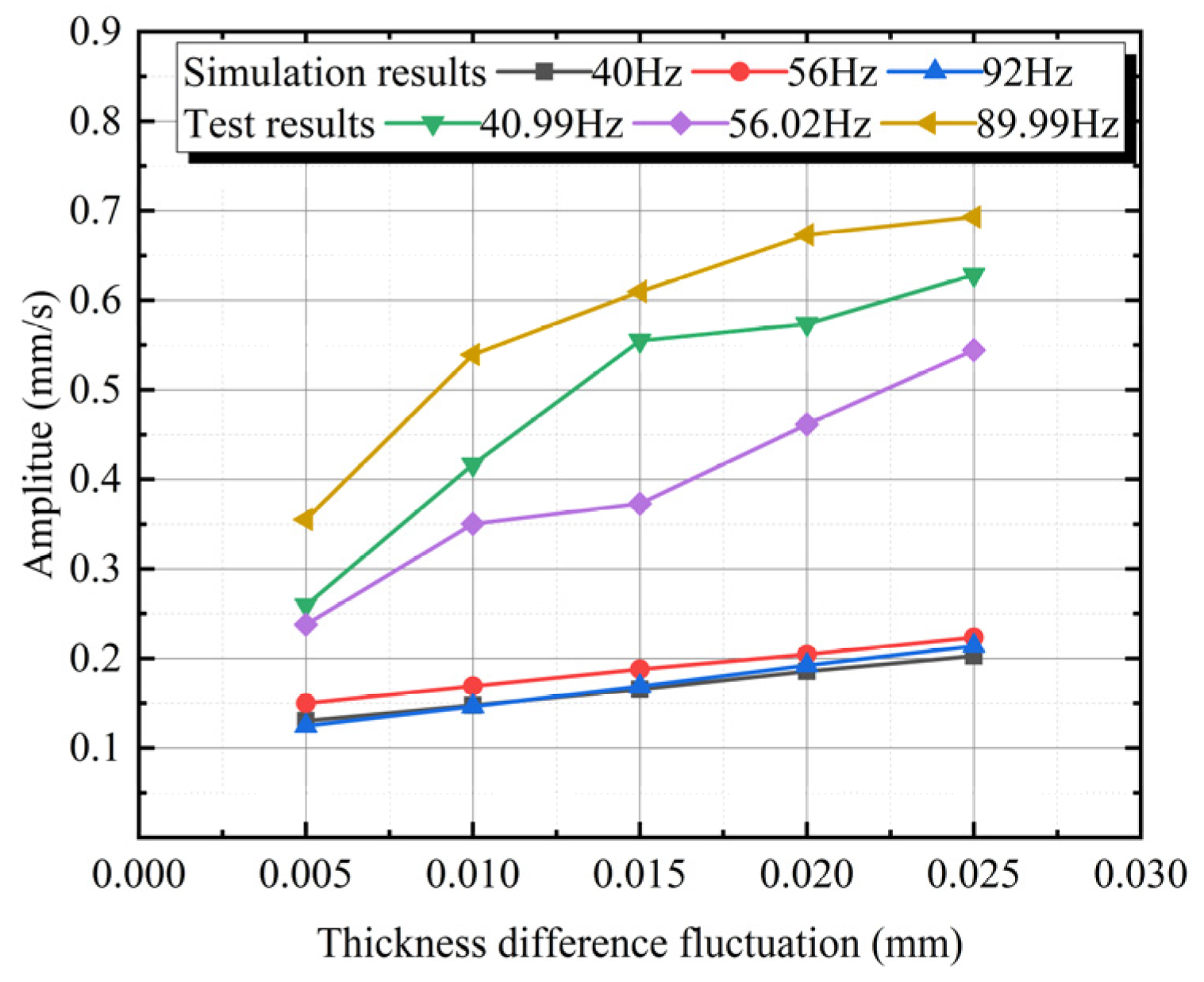

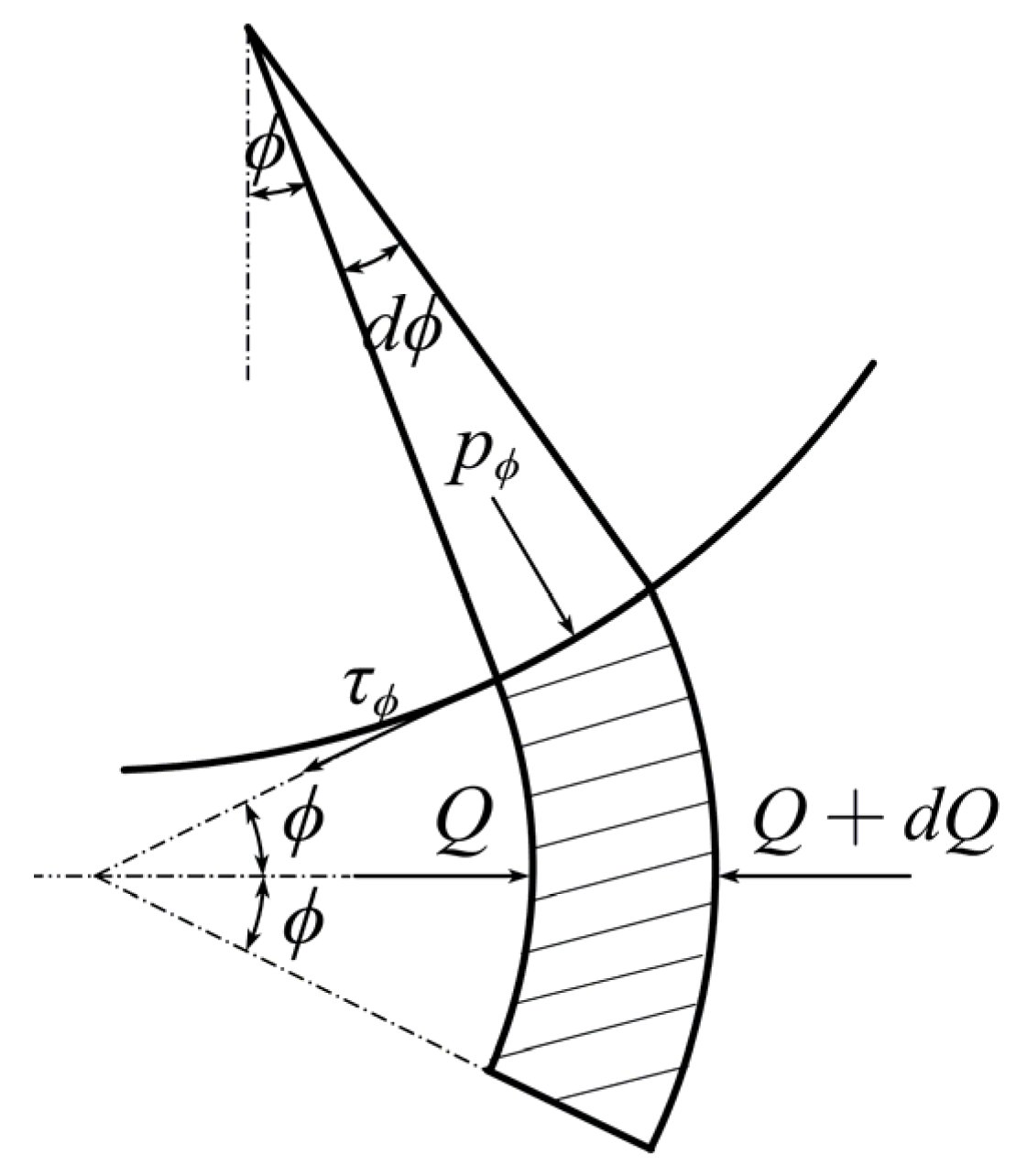

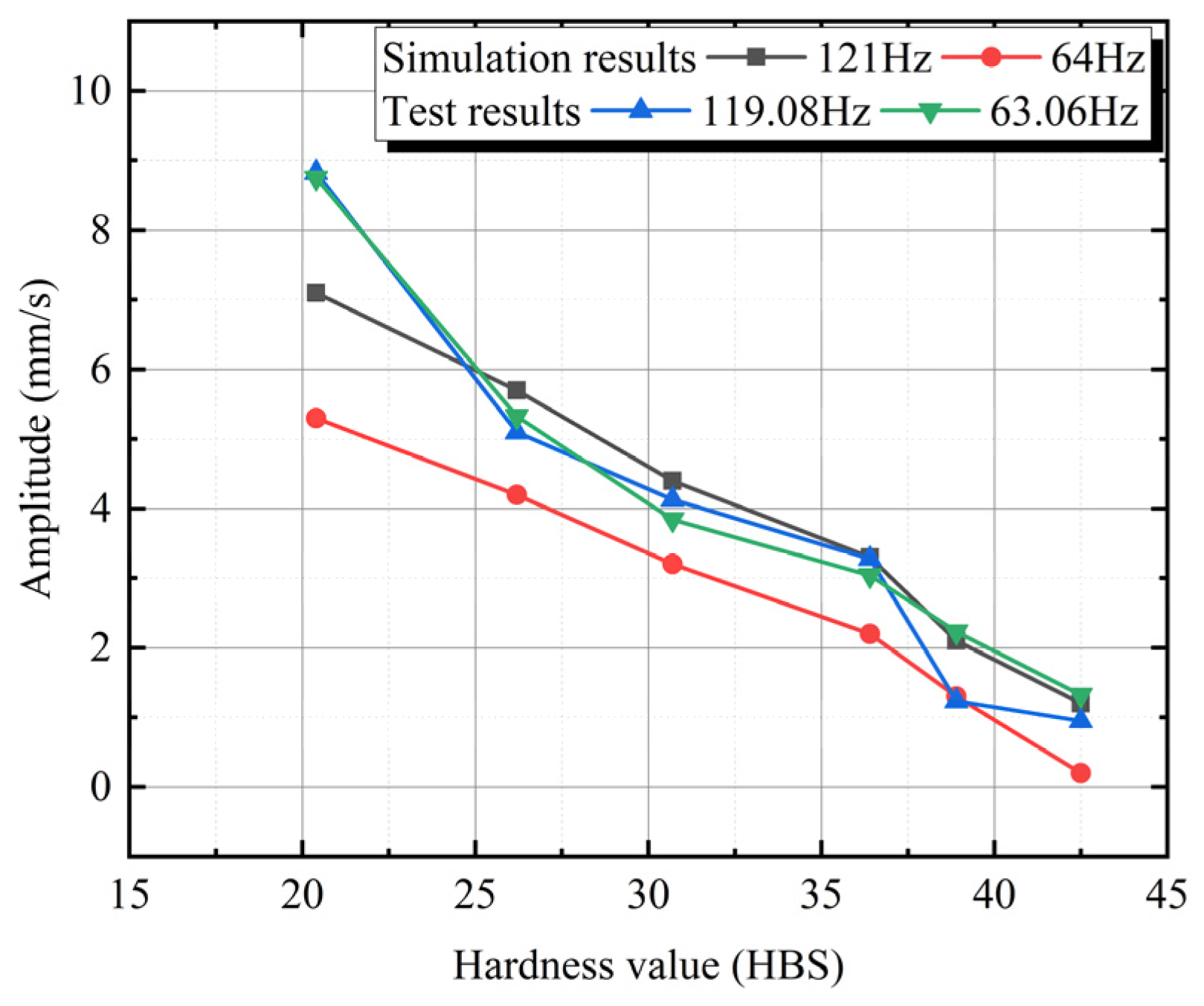
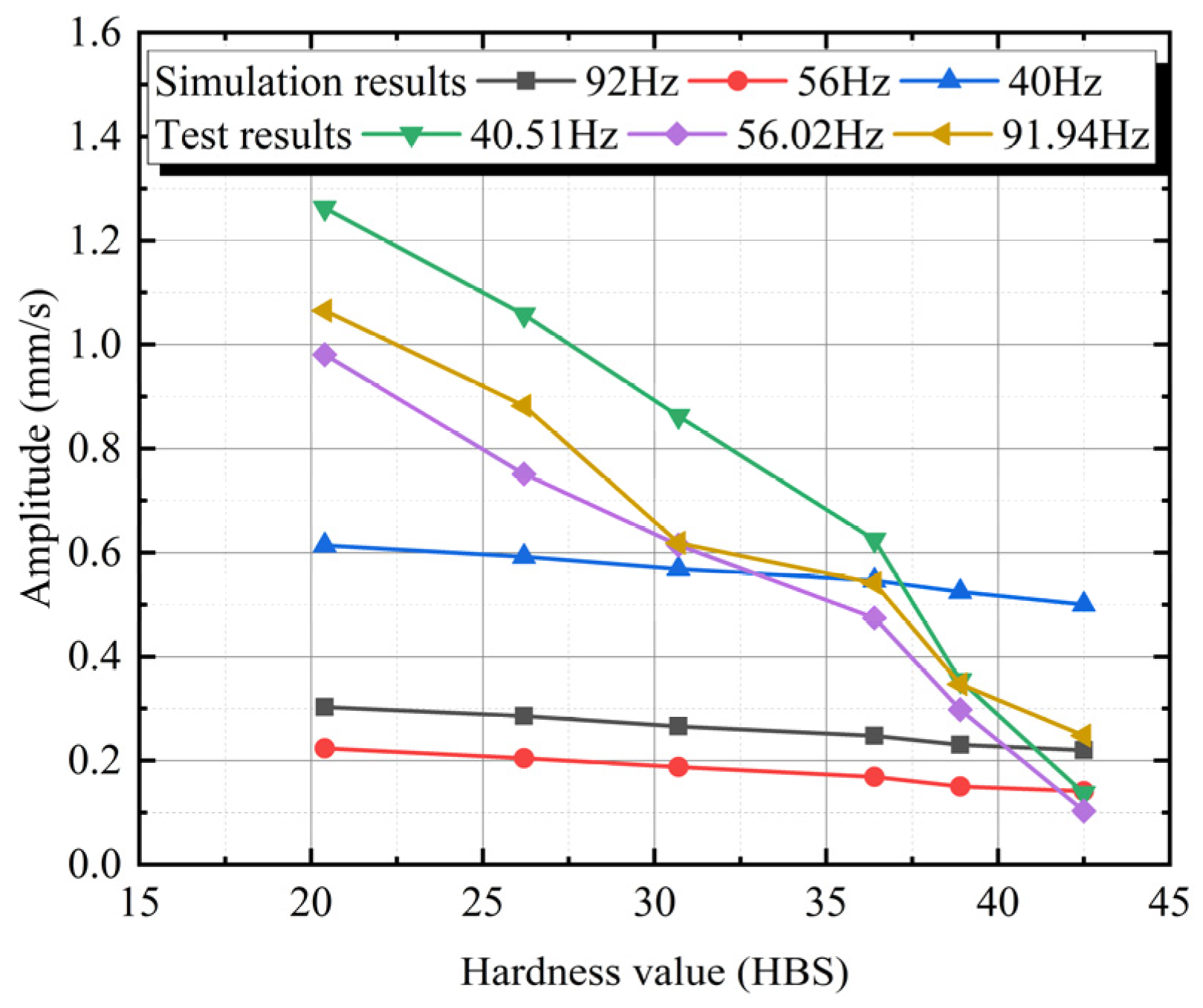
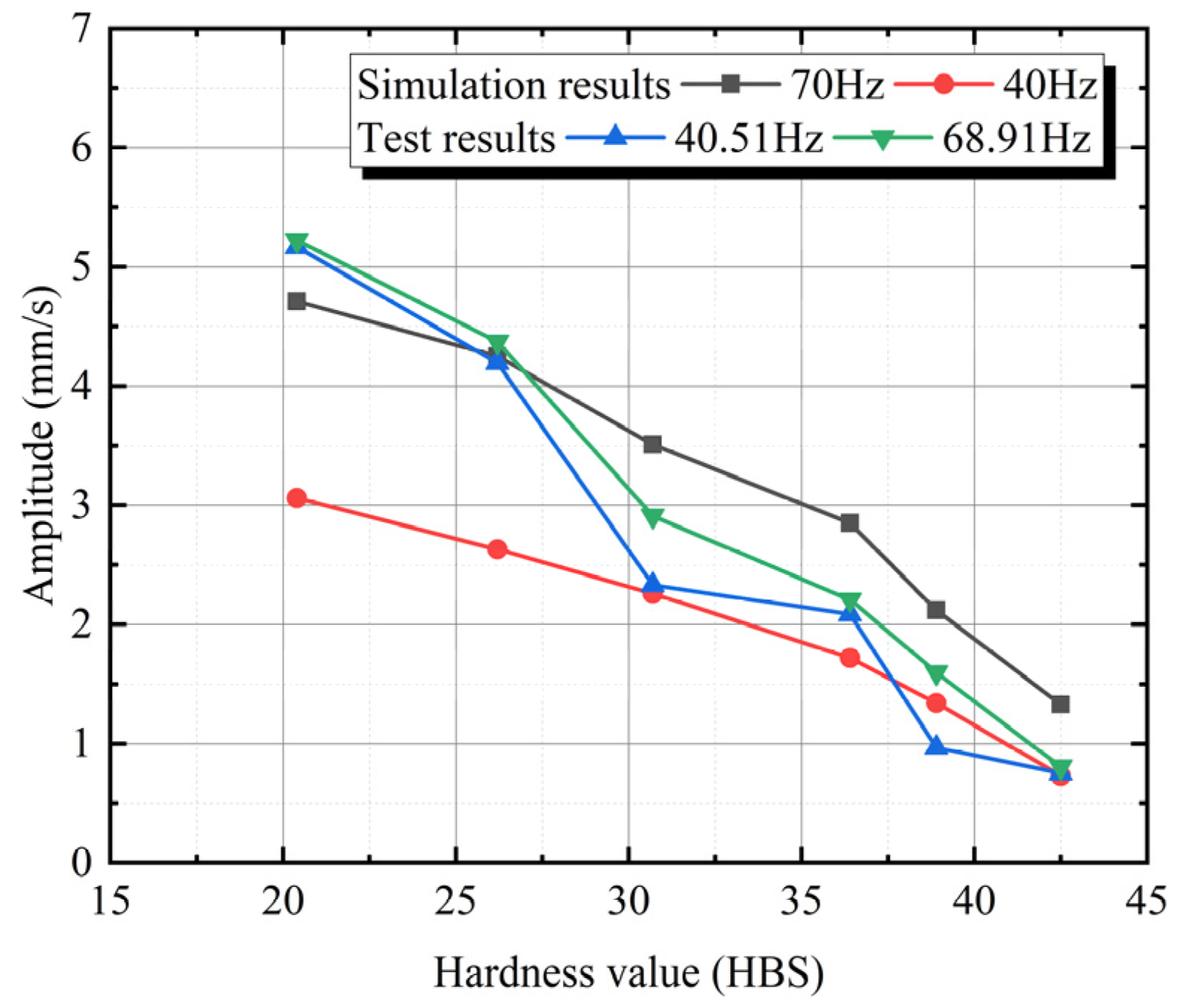
| Technical Name | Specification |
|---|---|
| Backup roll diameter | 1450 mm |
| Work roll diameter | 640 mm |
| Motor rotor moment of inertia | 6217 Kg·m2 |
| Reduction ratio | 1:1.3 |
| Reducer’s moment of inertia | 1370 Kg·m2 |
| The number of teeth of the reducer | 36/47 |
| Gear seat’s number of teeth | 47 |
| Gear seat’s moment of inertia | 2350 Kg·m2 |
| Poisson’s ratio | 0.3 |
| Young’s modulus | 2.1 × 1011 GPa |
| Density | 7800 |
| Strip steel grades | Q235b |
| Technical Name | Specification |
|---|---|
| Frequency measurement range | 0.1 Hz–12 KHz |
| Sensitivity | 10 mV/(mm·s−1) |
| Lateral sensitivity ratio | ≤5% |
| Amplitude linearity deviation | ±2% |
| Temperature response deviation | <0.1%/°C |
| Output load resistance | ≤500 Ω |
| Technical Name | Specification |
|---|---|
| Shaft diameter | 100 mm–1000 mm |
| Spinning speed | <9000 rpm |
| Sampling frequency | 2048 Hz/CH |
| Input range | ±2.5 V |
| Strain gauges | 100 Ω–KΩ (full bridge) |
| Strain accuracy | 0.3% |
| Power consumption | 5 V 100 mA |
| AD accuracy | 24-bit delta-sigma chip |
| Number of channels | 1 |
| Technical Name | Specification |
|---|---|
| Bandwidth | 1 Hz–10 KHz |
| Maximum sample rate | 51,200 Hz |
| Maximum input range | ±100,000 με |
| Resolution | 0.1 με |
| Overvoltage protection between terminals | ±60 V |
| Operating temperature | −20 to 85 °C |
| Stability | Temperature drift gain < 6 ppm/°C |
| Power supply | AC 220 V |
| Input channel accuracy | ≤0.2% |
| Input channel | 16 |
| Analog to digital converter | 24-bit AD, delta-sigma type |
Publisher’s Note: MDPI stays neutral with regard to jurisdictional claims in published maps and institutional affiliations. |
© 2022 by the authors. Licensee MDPI, Basel, Switzerland. This article is an open access article distributed under the terms and conditions of the Creative Commons Attribution (CC BY) license (https://creativecommons.org/licenses/by/4.0/).
Share and Cite
Wang, L.; Yan, X.; Jia, X.; Wang, X. Dynamic Amplitude-Frequency Characteristics of Vertical–Torsional Coupling System with Harmonic Response in Hot Tandem Mill. Electronics 2022, 11, 3031. https://doi.org/10.3390/electronics11193031
Wang L, Yan X, Jia X, Wang X. Dynamic Amplitude-Frequency Characteristics of Vertical–Torsional Coupling System with Harmonic Response in Hot Tandem Mill. Electronics. 2022; 11(19):3031. https://doi.org/10.3390/electronics11193031
Chicago/Turabian StyleWang, Lidong, Xiaoqiang Yan, Xingdou Jia, and Xiaoling Wang. 2022. "Dynamic Amplitude-Frequency Characteristics of Vertical–Torsional Coupling System with Harmonic Response in Hot Tandem Mill" Electronics 11, no. 19: 3031. https://doi.org/10.3390/electronics11193031
APA StyleWang, L., Yan, X., Jia, X., & Wang, X. (2022). Dynamic Amplitude-Frequency Characteristics of Vertical–Torsional Coupling System with Harmonic Response in Hot Tandem Mill. Electronics, 11(19), 3031. https://doi.org/10.3390/electronics11193031





